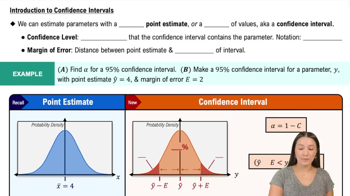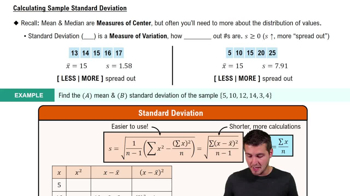Atkins Weight Loss Program In a test of weight loss programs, 40 adults used the Atkins weight loss program. After 12 months, their mean weight loss was found to be 2.1 lb, with a standard deviation of 4.8 lb. Construct a 90% confidence interval estimate of the standard deviation of the weight loss for all such subjects. Does the confidence interval give us information about the effectiveness of the diet?
Table of contents
- 1. Intro to Stats and Collecting Data1h 14m
- 2. Describing Data with Tables and Graphs1h 55m
- 3. Describing Data Numerically2h 5m
- 4. Probability2h 16m
- 5. Binomial Distribution & Discrete Random Variables3h 6m
- 6. Normal Distribution and Continuous Random Variables2h 11m
- 7. Sampling Distributions & Confidence Intervals: Mean3h 23m
- Sampling Distribution of the Sample Mean and Central Limit Theorem19m
- Distribution of Sample Mean - Excel23m
- Introduction to Confidence Intervals15m
- Confidence Intervals for Population Mean1h 18m
- Determining the Minimum Sample Size Required12m
- Finding Probabilities and T Critical Values - Excel28m
- Confidence Intervals for Population Means - Excel25m
- 8. Sampling Distributions & Confidence Intervals: Proportion1h 12m
- 9. Hypothesis Testing for One Sample3h 29m
- 10. Hypothesis Testing for Two Samples4h 50m
- Two Proportions1h 13m
- Two Proportions Hypothesis Test - Excel28m
- Two Means - Unknown, Unequal Variance1h 3m
- Two Means - Unknown Variances Hypothesis Test - Excel12m
- Two Means - Unknown, Equal Variance15m
- Two Means - Unknown, Equal Variances Hypothesis Test - Excel9m
- Two Means - Known Variance12m
- Two Means - Sigma Known Hypothesis Test - Excel21m
- Two Means - Matched Pairs (Dependent Samples)42m
- Matched Pairs Hypothesis Test - Excel12m
- 11. Correlation1h 6m
- 12. Regression1h 50m
- 13. Chi-Square Tests & Goodness of Fit1h 57m
- 14. ANOVA1h 57m
7. Sampling Distributions & Confidence Intervals: Mean
Introduction to Confidence Intervals
Problem 7.c.10a
Textbook Question
Tour de France Listed below are the average speeds (km/h) of winners of the Tour de France men’s bicycle race. The speeds are listed in order by year, beginning with the year 2000.
a. Construct a 95% confidence interval estimate of the population mean.
 Verified step by step guidance
Verified step by step guidance1
Step 1: Identify the sample data provided in the problem. These are the average speeds (in km/h) of the Tour de France winners from the year 2000 onward. Denote the sample size as n, the sample mean as \( \bar{x} \), and the sample standard deviation as \( s \).
Step 2: Determine the confidence level, which is 95% in this case. The corresponding critical value (\( t^* \)) can be found using a t-distribution table or statistical software, based on the degrees of freedom \( df = n - 1 \).
Step 3: Use the formula for the confidence interval of the population mean: \( \bar{x} \pm t^* \cdot \frac{s}{\sqrt{n}} \), where \( \bar{x} \) is the sample mean, \( t^* \) is the critical value, \( s \) is the sample standard deviation, and \( n \) is the sample size.
Step 4: Plug the values of \( \bar{x} \), \( t^* \), \( s \), and \( n \) into the formula. Compute the margin of error \( ME = t^* \cdot \frac{s}{\sqrt{n}} \). Then calculate the lower bound as \( \bar{x} - ME \) and the upper bound as \( \bar{x} + ME \).
Step 5: Interpret the result. The 95% confidence interval provides a range of values within which the true population mean of the average speeds is likely to fall, with 95% confidence.
 Verified video answer for a similar problem:
Verified video answer for a similar problem:This video solution was recommended by our tutors as helpful for the problem above
Video duration:
5mPlay a video:
Was this helpful?
Key Concepts
Here are the essential concepts you must grasp in order to answer the question correctly.
Confidence Interval
A confidence interval is a range of values, derived from sample statistics, that is likely to contain the population parameter with a specified level of confidence, typically 95%. It provides an estimate of uncertainty around the sample mean, indicating how much the sample mean might vary from the true population mean.
Recommended video:

Introduction to Confidence Intervals
Sample Mean
The sample mean is the average of a set of observations drawn from a larger population. It serves as a point estimate of the population mean and is calculated by summing all sample values and dividing by the number of observations. The sample mean is crucial for constructing confidence intervals.
Recommended video:

Sampling Distribution of Sample Proportion
Standard Error
The standard error measures the variability of the sample mean from the true population mean. It is calculated by dividing the sample standard deviation by the square root of the sample size. A smaller standard error indicates that the sample mean is a more accurate estimate of the population mean, which is essential for constructing a reliable confidence interval.
Recommended video:
Guided course

Calculating Standard Deviation

 6:33m
6:33mWatch next
Master Introduction to Confidence Intervals with a bite sized video explanation from Patrick
Start learningRelated Videos
Related Practice
Textbook Question
